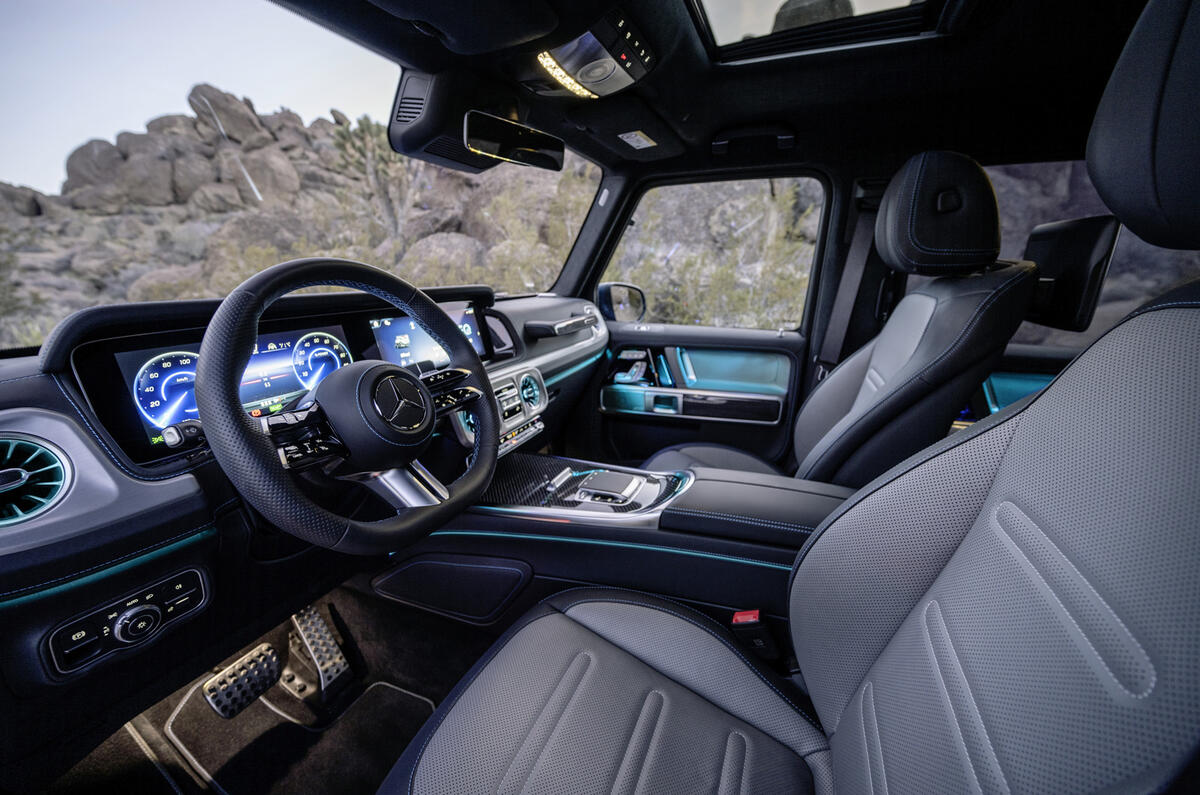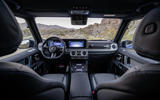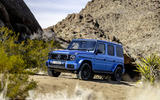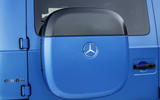Mercedes-Benz is planning to dramatically increase the range of its new electric G-Class with a new type of battery chemistry earmarked for production in just two years.
The new silicon-anode battery, currently at an advanced stage of development in a partnership between Mercedes and American company Sila Nanotechnologies, is set to be offered as an option from 2026 onwards in a move that Autocar has been told will significantly boost the range of the 4x4.
Revealed at the 2024 Beijing motor show, the G580 EQ arrives with a 116kWh (usable) battery with lithium nickel-manganese-cobalt cells, supplied by China's CATL, and graphite anodes. This provides the quad-motor EV with an official range of 292 miles.
But even before deliveries of the plush electric off-roader get under way, Mercedes officials have confirmed plans to upgrade the model with its most energy-dense battery to date.
Details revealed previously confirm the new silicon-anode battery provides a 20-40% increase in energy density, with prototype units reaching more than 800Wh per litre at cell level.
Even with 20% more energy in the same battery casing, the G580 EQ would benefit from a 23kWh increase in capacity to 139kWh. With the same 2.6mpkWh operating efficiency as the current car, this would increase range to somewhere in the region of 354 miles.
A 40% boost in density by the same measure would push capacity to 162kWh and thus could send the official range figure beyond 400 miles.
“Delivering such a high energy density is a true game-changer and allows us to think in completely new directions when developing future electric cars,” said Markus Schäfer, Mercedes' chief technology officer.
Mercedes invested in Sila Nanotechnologies in 2019. Since then, the two companies have worked closely to bring silicon-anode battery technology to large-scale production.
As well as being earmarked for the G580, the new battery is planned to be introduced to other Mercedes EVs, including the EQE and EQS saloons and SUVs.
Mercedes G580 with EQ Technology: everything you need to know
Known throughout its development as the EQG, the 4x4 is known as the G580 with EQ Technology in production form. The lengthy moniker represents a shift in the naming strategy for electric Mercedes vehicles, and also showcases how the G580 was developed to be a G-Class that just happens to be battery powered.
The G580 is virtually identical in design to the recently updated G450d, with a subtle reworking of the engine grille and discrete EQ badges to set it apart. But there has been extensive work to maximise aerodynamic efficiency, including a new A-pillar design and a new spoiler lip on the front of the roof.
The G580 also features a new aerodynamically sculpted bonnet, resulting in a drag coefficient of 0.44, down from 0.48Cd for the latest G450d, and 0.53Cd for the previous-generation G. In another move, the optional spare wheel holder mounted on the rear boot can be replaced with a similarly styled charging cable holder.
“The G is still the G,” said Manuel Urstöger, the head of e-drive systems for Mercedes-Benz G. “It’s not just design or sound: for us the powertrain is about offering uncompromised off-road ability.”

The G580 uses four electric motors, with one powering each wheel of the car. Each motor produces 145bhp, combining for a maximum output of 579bhp, along with a mammoth 859lb ft of torque.
The motors have been developed specially for the G580, and each is driven by a separate two-speed gearbox. Urstöger said that the unusual and highly complicated powertrain was developed specifically to meet the exacting specifications of the G division, and will not be used elsewhere in the line-up.
“It was a tough project,” he said, “but we achieved all our targets and because of that it’s better than the combustion-engined G when going off-road.”
The G580 retains the same independent front suspension, with a new rigid axle at the rear containing the integrated electric drive unit, and virtual rather than mechanical differential locks to offer optimised torque vectoring.

It has a 0-62mph time of less than five seconds and a top speed of 112mph, but the real focus is on delivering off-road performance, with Urstöger saying that the development briefs have been set to match or exceed the petrol G.
There is a shiftable low-range transmission, and Mercedes claims the G580 offers up to 100% gradeability on certain surfaces and the ability to traverse side slopes of up to 35 degrees.
The G580 also features a fording depth of 850mm, which because the electric powertrain elements are all sealed, is 100mm greater than the regular G – and is only limited because of the height of the charging port.
The only off-road area where the G580 falls short of the ICE G, Mercedes claims, is in ground clearance: the flat floor means that a small section of the centre of the floor sits slightly lower than the G450d.

In addition, the G580 offers three bespoke functions to aid off-road driving: a G-Turn, which allows it to rotate 720 degrees on the spot; G-Steering, which reduces the turning circle by enabling it to pivot around an individual wheel; and an off-road crawler function that can run as low as 1.2mph.
There is also a new ‘transparent bonnet’ function that uses the front facing cameras to project a forward view onto the infotainment screen to make tackling obstacles easier.
The G580 sits on a modified version of the G-Class’s ladder frame chassis, although with the batteries mounted directly into the frame in specially designed packs, which also serve as a structural part of the machine, removing the need for separate cross braces.
The 116kWh battery, shared with the EQS, can be fast-charged at speeds of up to 200kW and gives a claimed range of 292 miles, although as important for Mercedes, according to Urstöger, was how much off-roading that would allow.

“It’s surprising how long you can drive off-road,” he said, noting that the lower speeds and ability to use regen instead of brakes when descending are beneficial in this respect.
Urstöger highlighted the G580’s performance on the Schöckl mountain pass in Austria, a 3.5-mile pass featuring 700 metres of altitude gain at gradients of up to 60% that all G-Class are tested on, claiming the EV can complete the ascent and descent 14 times on a single charge.
The battery pack isn’t just used as part of the structure: a special underride guard developed to protect the battery from damage also acts as a skidplate when driving off-road. That helps offset some of the extra weight of the G580’s batteries, although at 3085kg it is 530kg heavier than the G450d.
The G580 will be offered with a special G-Roar function that offers an “emotive sound experience” in the cabin, which is virtually identical to the facelifted G450d, with a higher level of comfort kit than on previous models.
UK pricing and on-sale dates for the G580 with EQ Technology have yet to be revealed, but it is likely to sit between the G450d and the range-topping Mercedes-AMG G63.
New names for Mercedes EVs
The Mercedes-Benz G580 with EQ Technology introduces a new nomenclature for the German firm’s bespoke electric vehicle line-up.
The new electric off-roader was previewed with the Concept EQG, and had been expected to take that title through to production, following Mercedes’s strategy of using the EQ electric sub-brand for its battery-powered vehicles.
G-Class boss Toni Mäntele said that the switch to the G580 title is to emphasise that it is part of the main G-Class range, and reflects “a new strategy” for the next-generation of electric Mercedes cars. That will see them revert to the firm’s classic model names, with the EQ Technology suffix indicating their electric credentials.
The move won’t be applied to existing models, but the next-generation electric CLA, previewed with a Concept EQA at last year’s Munich motor show, is set to keep that title in production.














































Join the debate
Add your comment
OR instead of increasing range, make a 20% smaller (and presumably lighter) battery. So same KWh, 20% less weight, and improve efficiency (and range of course if there is less weight). But for the bad taste uberrich buying this I guess efficiency is not an issue...
Rubbish, emissions from a Toyota diesel are worse for the pedestrian, equivalent mpg figure is worse to, as is the acceleration and refinement. Different segment too.
Incorrect as usual, my angry little friend! Twin turbo petrol V6 emissions are cleaner than the air in most cities. Toyota refinement is superior. MPG and acceleration are irrelevant to body-on-frame 4WD wagons. it's like saying New beetle is superior becasue it has a vase on the dash.
The new Range Rover is supposed to have a greater wading depth, longer range and quite possibly will cost less. It will also go like a train on road. I'd buy that